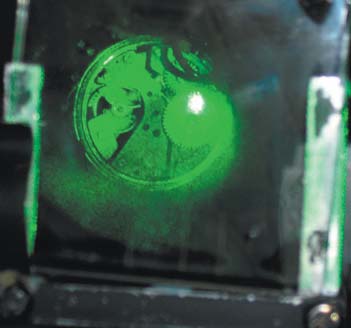| 2005 |

|
YEAR BOOK |
Dublin Institute of Technology
|
Reflection Holography at the IEO Centre
|

This has many potential applications, but until recently the work had been restricted somewhat by the resolution limit of the material which only allowed transmission holograms to be recorded. For practical purposes, this meant that a laser was required to reconstruct the three dimensional image, and the hologram was not visible in ordinary white light. Reflection holograms, which can be viewed in ordinary white light, require higher resolution than the IEO recording material could record at that time.
The material's other advantages meant that even as a transmission�only material it had potential. It is cheap and easy to produce, self-developing, sensitive to a wide range of laser wavelengths, and has very high diffraction efficiency (diffraction efficiency is the measure of how bright the recorded hologram is, and is used to compare one holographic recording material with another).
However, a breakthrough in the materials research has meant that it is now possible to record bright reflection holograms, visible in white light, in the IEO material. The first high diffraction efficiency reflection hologram successfully recorded in the IEO material (shown in the inset) will open the door to applications in security, display and spectroscopy, without the need for chemical or physical processing of the material.
This advance has been a direct result of the increase in research activity in this area, as a concerted effort has recently been made to extend the capabilities of the IEO material. Some IEO researchers (Mr Shridar Reddy and Mr Hosam Sherif) have worked on new applications in holographic interferometry and holographic data storage, while others (Dr Izabela Naydenova and Mr Raghavendra Jallapuram) focussed on improving the material characteristics and recording processes in the hope of extending the resolution capabilities of the IEO photopolymer. Dr Emilia Mihaylova is using the material in new types of speckle shearing interferometer while Ms Pavani Kotakonda is developing new hybrid devices incorporating liquid crystals and photopolymers.
New commercial applications have been identified, and the group has been awarded funding under the Enterprise Ireland Commercialisation fund in order to investigate these further. The IEO's other research interests are in optical metrology (Mr Michael O'Hora) and Photogrammetry (Ms Fiona Coyle) and the Centre also offers consultancy services including surface metrology.
Contact: Dr Vincent Toal, Centre Director,
or Dr Suzanne Martin, Manager,
The Centre for Industrial and Engineering Optics,
Dublin Institute of Technology, Kevin Street, Dublin 8; Tel: (01) 402 4560 or (01) 402 4613;
E-mail: [email protected] ; [email protected] ;: www.ieo.dit.ie